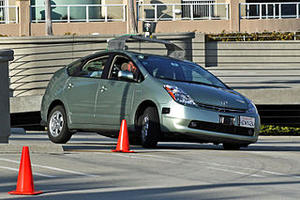Driverless carsAnn Arbor to offer residents networked, driverless cars by 2021
By 2021, Ann Arbor could become the first American city with a shared fleet of networked, driverless vehicles. This is the goal of the Mobility Transformation Center, a cross-campus University of Michigan initiative that also involves government and industry representatives.

Google's driverless car during testing // Source: commons.wikimedia.org
By 2021, Ann Arbor could become the first American city with a shared fleet of networked, driverless vehicles. This is the goal of the Mobility Transformation Center, a cross-campus University of Michigan initiative that also involves government and industry representatives.
“Ann Arbor will be seen as the leader in 21st century mobility,” said Peter Sweatman, director of the U-M Transportation Research Institute. “We want to demonstrate fully driverless vehicles operating within the whole infrastructure of the city within an eight-year timeline and to show that these can be safe, effective and commercially successful.”
Autonomous vehicles could change how people and goods move around in a way that the auto industry hasn’t seen since its inception, researchers say.
“We’ve now entered into a period where the technology and the business models are coming together to allow us to break out of this 100-year dependence on what we’ve always known,” said Larry Burns, a professor of practice at Michigan Engineering and former head of research and development for General Motors.
A University of Michigan release reports that for self-driving vehicles to bring this revolution, though, they have to be at the center of a reimagined transportation system in which vehicles are networked and shared. Simply replacing conventional models with driverless ones won’t achieve the maximum benefits, Burns says.
Through the Mobility Transformation Center, U-M is working toward this goal. Researchers are in the midst of the nation’s largest street-level connected vehicle experiment, called Safety Pilot, which involves some 3,000 area residents in networked vehicles. In October, U-M regents approved plans for a one-of-a-kind driverless car test environment near North Campus. The 30-acre, $6.5 million facility — a joint project with industry and government — will simulate a dynamic cityscape where researchers can test how the vehicles perform in complex urban settings.
— Read more in Nicole Casal Moore, “Driverless, connected cars: Ann Arbor as an early adopter,” Michigan Engineering, 5 November 2013
